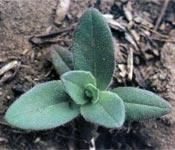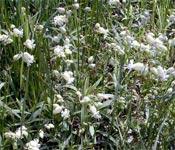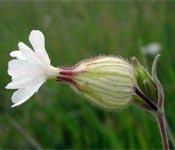- Ag. Service Board
- A.S.B. Members
- About Us
- Annual Report
- A.S.B. Minutes
- Programs, Services
& Rental Equipment - Invasive Weeds
- Crop Diseases & Pests
- Tree Diseases & Pests
- Planting Shelterbelts
- Vertebrate Pests
- Alberta Rat Control Program
- Municipal Tankloaders
- Agricultural Pesticide Empty
Container Collection Sites - Farm Family Awards
- Municipal Photo Contest
- Newsletters
- Upcoming Events & Updates
- Photo Gallery
- Links
White Cockle (Silene alba)
Family - Pink Caryophyllaceae
Life Cycle - biennial, simple perennial
Habitat - reduced tillage, forage crops, hay fields, roadsides, waste areas
Key Features
- Opposite, softly hairy leaves
- Swollen nodes
- Large, white, showy flowers
- Capsule opening by ten teeth
Seedling
Cotyledons are stalked, ovate in shape and somewhat constricted at the tips. The true leaves are soft and hairy on both surfaces and margins. They are oppositely arranged, elliptical and have short, hairy petioles.
Juvenile
White cockle has a fleshy tap root and forms a rosette in the first year. Stems are erect, covered with hair and swollen at the nodes. The middle and upper leaves are sessile, opposite, elliptical and softly hairy. The stems and leaves of the white cockle are not sticky to the touch like those of night-flowering catchfly.
Mature
The flowers of white cockle are large and showy, each with five notched white petals. Flowers on one plant are either all male or all female. The calyx surrounding male flowers is hairy with ten veins. They hairy calyx of female flowers has twenty veins, five of which are very distinct, the others less so. The female flower forms a light brown capsule that opens with ten teeth. The seeds are greyish, bumpy and kidney-shaped. Night-flowering catchfly has calyx veins that are more distinctly branched than white cockle. Also, the capsule of night-flowering catchfly opens with only six teeth. The overall stickiness of mature night-flowering catchfly is the easiest way to distinguish it from white cockle.
- Prohibited Noxious
- Hoary Alyssum
- Spotted Knapweed
- Nodding Thistle
- Noxious
- Common Baby's-breath
- Downy Brome
- Great & Lesser Burdock
- Scentless Chamomile
- Yellow Clematis
- White Cockle
- Oxeye Daisy
- Leafy Spurge
- Common Tansy
- Canada Thistle
- Yellow Toadflax
Juvenile

Mature

Flower

